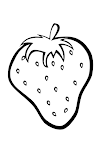Creating fruit coloring pages for kids can be a delightful and educational activity. Here's a step-by-step guide to help you design your own fruit coloring pages.

Stage 1: Pick Your Organic Products
Select different natural products that you need to highlight in your shading pages. Well-known choices incorporate apples, bananas, oranges, grapes, strawberries, and watermelons, and that's just the beginning. You can pick natural products in light of their shapes, varieties, and appeal to kids.
Stage 2: Sketch the Layout
Utilize visual depiction programming or attract by hand to draw the diagram of each natural product on a clear piece of paper. Keep the shapes basic and conspicuous, making it simple for youngsters to recognize the natural products they are shading.
Stage 3: Add Subtleties
When you have the essential layouts, add basic subtleties to each natural product. Incorporate elements like stems, leaves, seeds, or surface lines to make the natural products look more practical. Be aware of keeping the subtleties age-proper for youngsters.
Stage 4: Separation into Areas
Partition each natural product shading page into various areas utilizing light lines. This will assist jokes with recognizing various pieces of the natural product while shading. Areas can incorporate the skin, tissue, seeds, and any extra subtleties.
Stage 5: Print the Shading Page
Print the natural product shading pages on a piece of paper or cardstock. Make sure the lines are understood and dim to the point of being apparent but not excessively thick so that they overpower the shading system. Think about printing various duplicates to have a lot of pages for shading.
Stage 6: Shading Time
Furnish the printed shading pages alongside pastels, hued pencils, or markers, and let the children release their imagination! Urge them to explore different avenues regarding various varieties and concealing methods to rejuvenate the organic products on the page.
Stage 7: Discretionary: Add Instructive Components
Consider adding instructive components to the shading pages, for example, marking the names of each natural product or including fun realities about them. This can make the shading action both engaging and instructive for youngsters.
Stage 8: Offer and Show
When the shading is finished, urge children to show their hued natural product work of art or offer it to loved ones gladly. You can make a display of their fine art or host a shading challenge to praise their inventiveness.
Planning natural product shading pages for youngsters is a phenomenal method for acquiring various kinds of organic products while likewise advancing inventiveness and fine-coordinated movements. By following these means, you can make drawings in shading pages that give long stretches of tomfoolery and learning for kids.






0 Comments